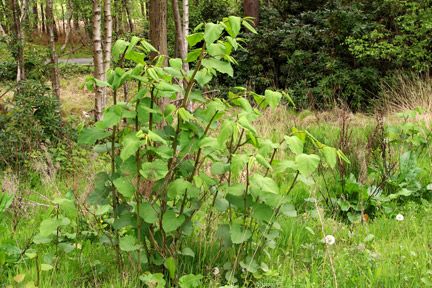Japanese knotweed
Invasive plants negatively impact on native species and habitats, transforming and threatening whole ecosystems.They can cause serious problems to rural and urban economies, and the environment. Invasive weeds cause extensive damage to property, reduce land value and spoil aesthetic appeal.
Whether you're a homeowner wanting to rid your residential property of Knotweed or a commercial site looking for advice on a larger scale invasion, our highly qualified team will deliver a no-nonsense practical guidance in accordance with your needs.
We pride ourselves on being reliable, honest and professional in the services that we deliver. We offer a highly competitive invasive weed control service delivering solutions to domestic and commercial clients.

What we provide you with:
- Initial surveys carried out free of charge
- The same trained technician on every routine service
- Written Japanese knotweed management plan
- On-going survey reports
Giant hogweed
Giant hogweed is a close relative of cow parsley, originally from Southern Russia and Georgia, it can reach over 3m (10ft) in height.
Although this striking plant can be attractive in certain situations, most gardeners will want to eradicate it, as it is potentially invasive, and the sap can cause severe skin burns. It is widely distributed in the wild and poses a serious risk to people who are unaware of its potential for harm.

Rhododendron
Although the flowers are attractive, rhododendron has few other attributes that offset the negative impact it can have on a site that it invades.
It is an aggressive coloniser that reduces the biodiversity value of a site, it obstructs the regeneration of woodlands and once established is difficult and costly to eradicate. As bushes mature and occupation of an invaded site increases, physical access can be reduced by the sheer density and size of the plants present, and the cost of some management operations (e.g. felling) can increase if the bushes require treatment first.
Mature bushes also act as a prolific seed source for invasion of adjacent areas, and are a continued source of new plant material into areas successfully cleared.

Himalayan balsam
Himalayan balsam is a relative of the busy Lizzie, but reaches well over head height, and is a major weed problem, especially on riverbanks and waste land, but also in gardens and allotments.
Fast growing Himalayan balsam tolerates low light levels and also shades out other vegetation, so gradually impoverishing habitats by killing off other plants. It is sometimes seen in gardens, either uninvited or grown deliberately, but care must be taken to ensure that it does not escape into the wild. The Himalayan balsam is a tall growing annual, 2-3m (6-10ft) in height.


